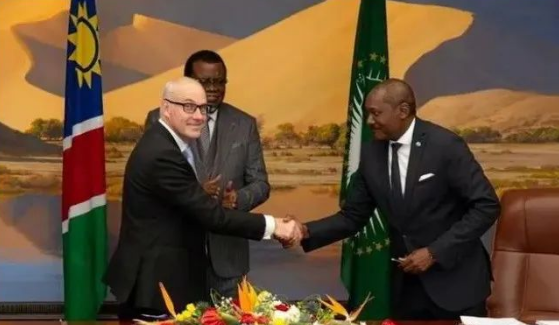On November 6, Africa’s first industrial-scale, zero-emission steel production project using green hydrogen broke ground in Namibia. Located near Arandis in Namibia’s Erongo region. Therefore the direct-reduced iron project is backed by the German government and has an initial investment phase totaling 13 million euros (about $13.9 million). The project will be implemented by HyIron, a consortium of German companies and Namibian partners. It including CO2Grab GmbH, TS Elino GmbH and LSF GmbH.
The Namibia Investment Promotion and Development Board (NIPDB) said in a statement that the project will start production by the end of 2024 with a capacity of 15,000 tons/year of direct reduced iron.
The investment is part of a series of joint projects between Namibian and German companies facilitated by the NIPDB. Rainer Baake, the German-Namibian Special Envoy for Energy and Climate Cooperation. Then he said the sponge iron produced by the project will supply German steel companies with raw materials for the production of green steel for wind turbines or automobile production.
Namibia is one of the top five low-cost hydrogen production sites in the world. It benefiting from the co-distribution of offshore onshore wind and solar resources and onshore export routes to markets. As a result, the development of green hydrogen has identified as an important industry to drive economic growth and assist Namibia. And the world in meeting global decarbonization targets.
1. Unique scenic resources and geographical location.
Namibia is particularly suitable for the development of large-scale hydrogen production because of its unique natural conditions and geographical location.
Excellent wind and light resources – Namibia’s average annual sunshine is 7-9 hours/day. It has a high intensity of sunshine; the average annual wind speed is between 5-7 m/s in most areas, and up to 8-9 m/s in some areas. All are at a high level globally.
Rich land resources – Namibia’s coastline is 1,600 kilometers long, with the world-famous Namib Desert area along the coast. It is sparsely populated, making it the least densely populated country in the world.
The nine ports in Namibia, an important transportation hub in Southern Africa, make it a maritime gateway to the Southern African region. It providing shipping services and transportation networks to neighboring countries. And playing an important role in the Southern African region in terms of infrastructure, logistics and trade.
2. Costs have a developmental advantage.
Due to its abundant solar and wind energy resources, it provides a good basis for low-cost green hydrogen production. According to IEA data, Namibia expected to have the second-highest cost of green hydrogen production in the world after Chile.
3. Active promotion at the national level.
Namibia has positioned the development of hydrogen energy as a national strategy, taking the hydrogen energy industry as an important economic pillar of the country in the future. And released a strategic plan related to the development of hydrogen energy in 2022. According to the plan, by 2030, the hydrogen energy industry will contribute $4.1 billion to Namibia’s GDP. It bringing a growth rate of more than 32% to the country’s GDP.
In May 2023 the Government of the Republic of Namibia and Hyphen Hydrogen officially signed an agreement for the US$10 billion Green Hydrogen Project. It is also the largest Green Hydrogen project in Sub-Saharan Africa.

The shareholders of Hyphen Hydrogen Energy are Nicholas Holdings Limit, an investment holding company and project developer, and Enertrag. A German renewable energy company. Then his objective is to develop, construct and operate a green hydrogen production facility in Namibia to supply international and regional markets.